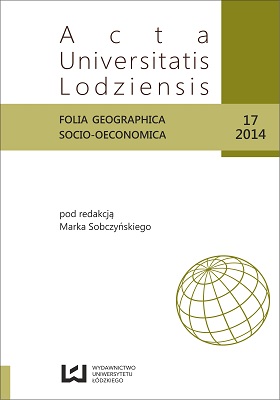Planowanie społeczne w europejskich obszarach stykowych: geografia polityczna miejsca
DOI:
https://doi.org/10.18778/1508-1117.17.02Słowa kluczowe:
planowanie przestrzenne, integracja przestrzenna, obszary stykoweAbstrakt
W artykule podjęto kwestię planowania społecznej i przestrzennej integracji w tak zwanych obszarach stykowych, gdzie różne jednostki polityczne i kulturowe spotykają się i wzajemnie na siebie oddziałują. Badania takich obszarów obejmują zarówno trwałe i immanentne dla ludzkości formy terytorialności oraz narastające problemy funkcjonalnej, społecznej, gospodarczej i przestrzennej (re)integracji. Oba trendy prowadzą do wielopoziomowych i często sprzecznych związków pomiędzy różnymi terytoriami i granicami, które wyłaniają się z równolegle postępujących procesów konwergencji i dywergencji społecznej i przestrzennej. Z tego powodu, zarówno teoria, jak i praktyka geografii politycznej staje w obliczu zmian w polityce integracji i/lub separacji. W związku z tym społeczne i przestrzenne planowanie w europejskich regionach wielokulturowych i pogranicznych wydaje się być trudną, żeby nie powiedzieć, syzyfową pracą. Pomimo to planowanie społeczne jest kluczowe dla stworzenia bardziej stabilnych możliwości, zarówno współistnienia, jak i rozwoju. Artykuł zawiera przegląd rozważań autora o polityczno-geograficznych przemianach i zagadnieniach związanych z europejskimi obszarami kontaktowymi w okresach przednowoczesnym, współczesnym i postmodernistycznym, ze szczególnym uwzględnieniem mniejszości i współpracy transgranicznej. Autor sugeruje, aby promować podejście integracyjne i wielopoziomowe, które mogłyby w jakiś sposób zastąpić klasyczne „narodowe” polityki w odniesieniu do rozwoju obszarów przygranicznych i ochrony mniejszości.
Bibliografia
Armstrong W., Anderson J. (eds.), 2007, Geopolitics of European Union Enlargement, Abingdon, Routledge.
Google Scholar
DOI: https://doi.org/10.4324/9780203448984
Blatter J.K., 2003, Debordering the world of states: toward a multi-level system in Europe and a multi-polity system in North America? Insights from border regions, [w:] Brenner N. et al. (ed.), State/Space – A Reader, Oxford, Blackwell, s. 185–207.
Google Scholar
DOI: https://doi.org/10.1002/9780470755686.ch11
Bufon M., 1999, Problematika teritorialnosti v politični in kulturni geografiji, „Geografski vestnik”, 71, Ljubljana, s. 91–103.
Google Scholar
Bufon M., 2001, From geopolitics to political geography: the new European challenge, [w:] Antonsich M. et al. (ed.), Europe between Political Geography and Geopolitics, Vol. 1, Roma, Societa’ Geografica Italiana, s. 335–346.
Google Scholar
Bufon M., 2003, Minorities, regional transformation and integration in borderlands: a case study, Annales, Series historia et sociologia, 13(1), Koper, s. 1–8.
Google Scholar
Bufon M., 2004, Med teritorialnostjo in globalnostjo, Koper, Annales.
Google Scholar
Bufon M., 2006a, Between social and spatial convergence and divergence: an exploration into the political geography of European contact areas, „GeoJournal”, 66(4), Dordrecht, s. 341–352.
Google Scholar
DOI: https://doi.org/10.1007/s10708-006-9008-1
Bufon M., 2006b, Geography of border landscapes, borderlands and euroregions in the enlarged EU, „Rivista Geografica Italiana”, 113(1), Firenze, s. 47–72.
Google Scholar
Bufon M., 2010, Planning integration in European areas of social and cultural contact: a Sysiphean task?, Treaties and Documents – „Journal of Ethnic Studies”, 62, Ljubljana, s. 74–90.
Google Scholar
Bufon M., 2011, Cross-border policies and spatial and social integration: between challenges and problems, „European Spatial Research Policy”, 18(2), Łódź, s. 29– 45.
Google Scholar
DOI: https://doi.org/10.2478/v10105-011-0011-2
Bufon M., 2013, It is possible to “measure” the intensity of cross-border cohesion? A case study of Slovene border areas, Annales, 23(1), Koper, s. 165–176.
Google Scholar
Bufon M., 2014, Spatial and social (re)integration of border and multicultural regions: creating unity in diversity?, [w:] Bufon M., Minghi J., Paasi A. (eds.), The New European Frontiers – Social and Spatial (Re)Integration Issues in Multicultural and Border Regions, Newcastle upon Tyne, Cambridge Scholars Publishing, s. 2–23.
Google Scholar
Bufon M. et al. (eds.), 2014, The New European Frontiers – Social and Spatial (Re)Integration Issues in Multicultural and Border Regions, Newcastle upon Tyne, Cambridge Scholars Publishing.
Google Scholar
Calhoun C., 2003, The democratic integration of Europe, [w:] Berezin M. in Schain M. (ed.), Europe without Borders, Baltimore, The Johns Hopkins University Press, s. 243–274.
Google Scholar
Caporaso J.A., 1996, The European Union and forms of state: Westphalian, regulatory or post-modern?, „Journal of Common Market Studies”, 34(1), s. 29–51.
Google Scholar
DOI: https://doi.org/10.1111/j.1468-5965.1996.tb00559.x
Casey E.S., 1997, The Fate of Place: A Philosophical History, Berkeley, University of California Press.
Google Scholar
Castles S. in Miller M.J., 2003, The Age of Migrations (Third edition), New York, The Guilford Press.
Google Scholar
Entrikin J.N., 2003, Political community, identity, and cosmopolitan place, [w:] Berezin M. in Schain M. (ed.), Europe without Borders, Baltimore, The Johns Hopkins University Press, s. 51–85.
Google Scholar
Held D. et al., 1999, Global Transformations: Politics, Economics and Culture, Oxford, Polity Press.
Google Scholar
DOI: https://doi.org/10.1057/9780333981689_2
Keating M., 1996, The invention of regions: political restructuring and territorial government in Western Europe, Working paper for ARENA (Advanced Research on the Europeanisation of the Nation-state).
Google Scholar
Paasi A., 2002, Bounded spaces in the mobile world-deconstructing “regional identity”, TESG 93, Utrecht, s. 137–148.
Google Scholar
DOI: https://doi.org/10.1111/1467-9663.00190
Poulantzas N., 1978, State, Power, Socialism, London, New Left Books.
Google Scholar
Sack R.D., 1980, Conceptions of Space in Social Thought, London, Macmillan.
Google Scholar
DOI: https://doi.org/10.1007/978-1-349-16433-2
Smith A.D., 1995, Nations and Nationalism in a Global Era, Cambridge, Polity Press.
Google Scholar
Williams C.H., 1997, Territory, identity and language, [w:] Keating M. in Loughlin J. (ed.), The Political Economy of Regionalism, London, Frank Cass, s. 112–138.
Google Scholar
Williams C.H., 2013, Minority Language Promotion, Protection and Regulation – The Mask of Piety, Basingstoke, Palgrave Macmillan.
Google Scholar
DOI: https://doi.org/10.1057/9781137000842
Pobrania
Opublikowane
Jak cytować
Numer
Dział
Licencja

Utwór dostępny jest na licencji Creative Commons Uznanie autorstwa – Użycie niekomercyjne – Bez utworów zależnych 4.0 Międzynarodowe.








